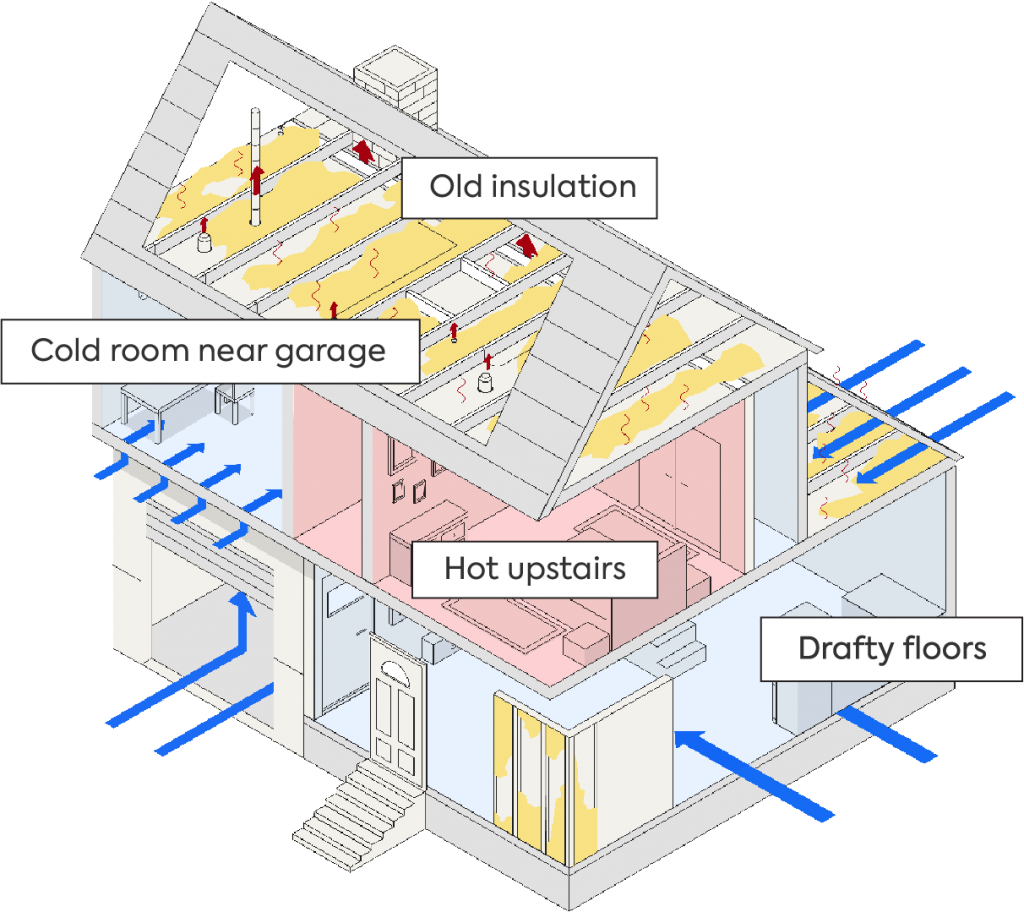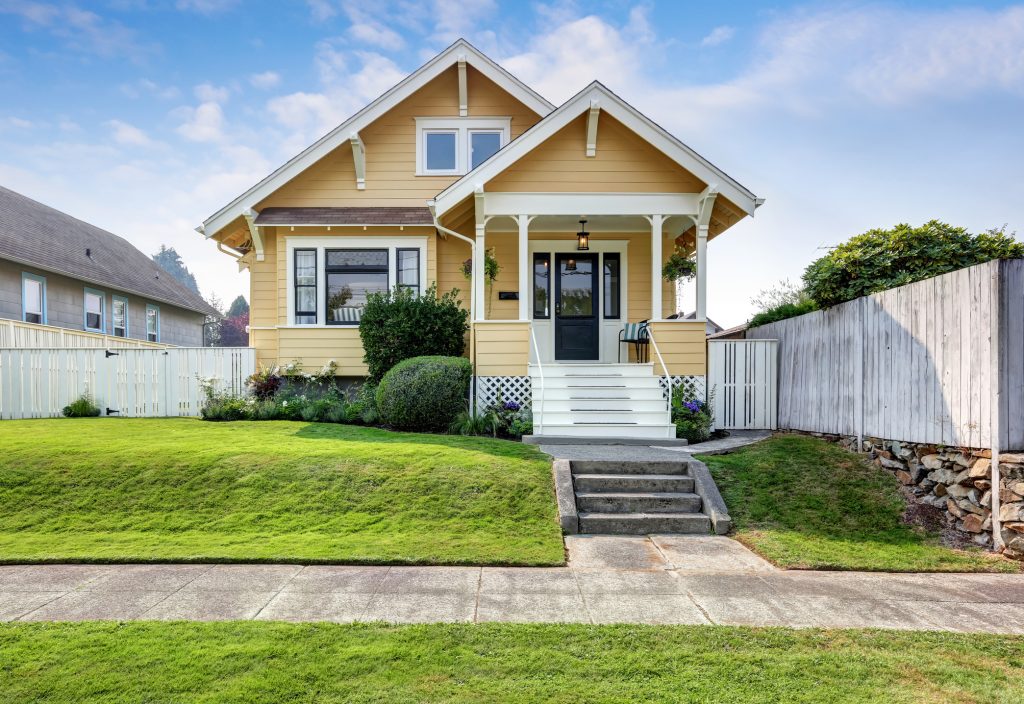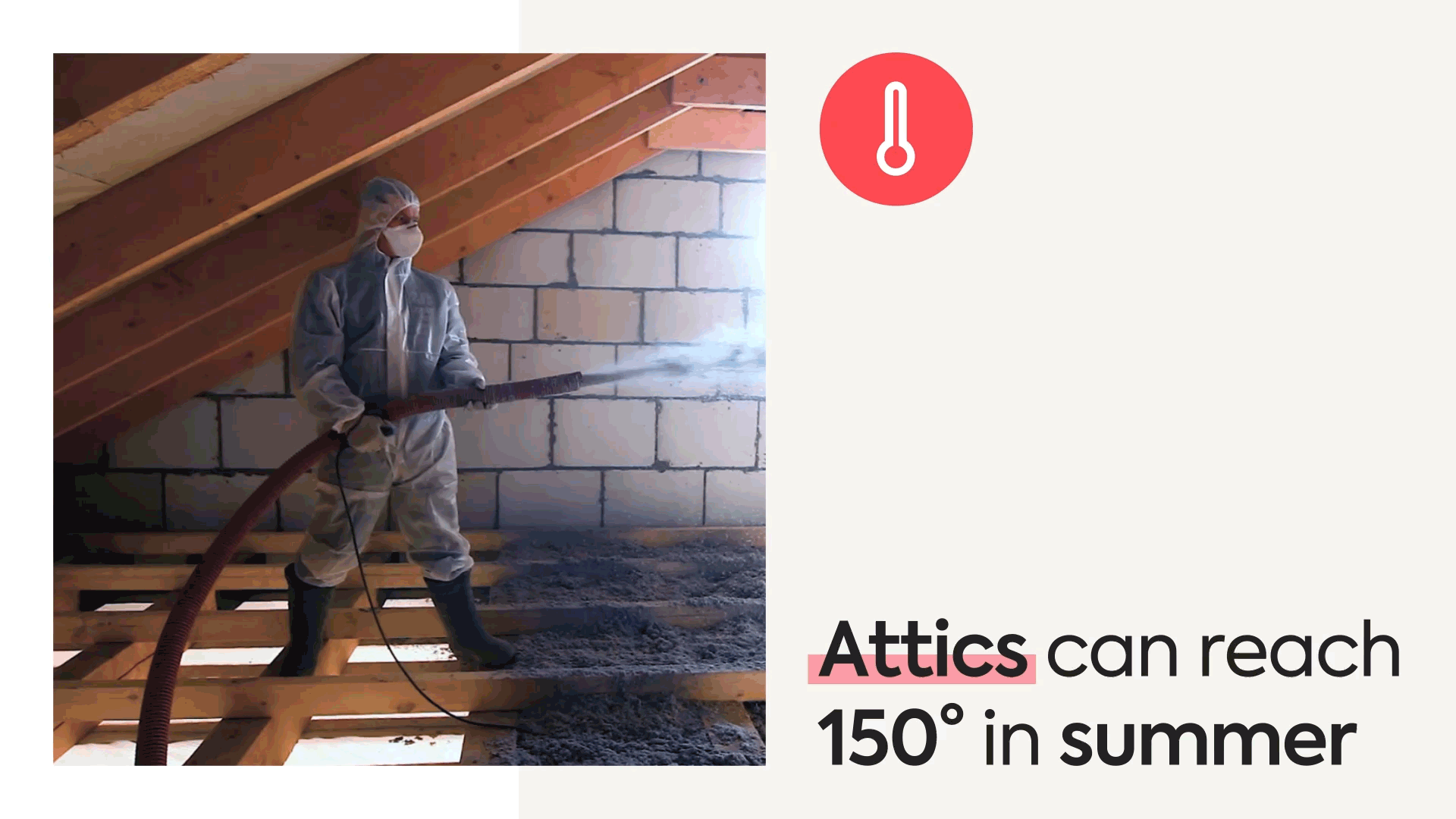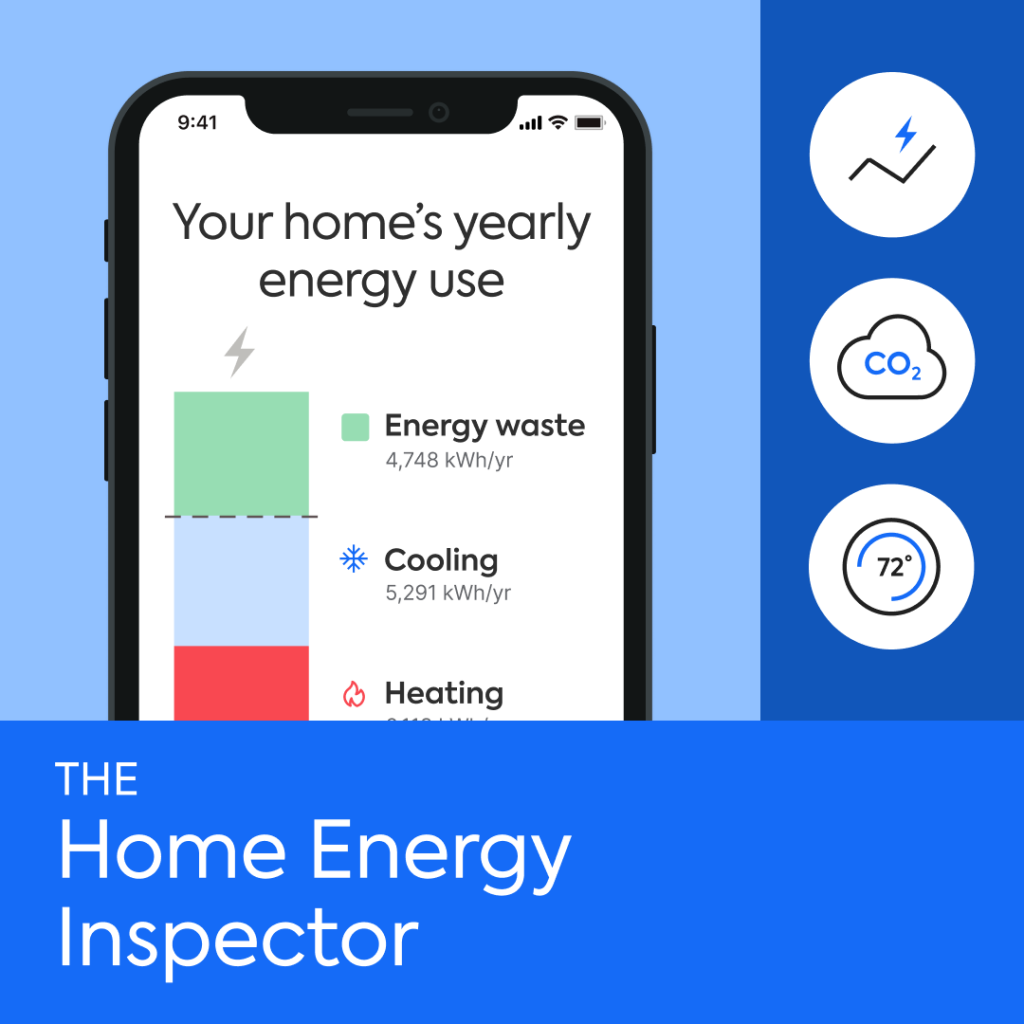Make your home more comfortable and efficient. Discover extra financial incentives to make it happen.
Weatherizing your home is one of the smartest, wisest ways to make your house more efficient, healthier for people and pets, and feel better year round.
And here’s more good news: Federal weatherization tax credits and home weatherization rebates have been expanded.
Not to mention, there are local programs you can take advantage of to get this work done, too. (Find out how to get top-to-bottom home weatherization at no upfront cost here.)
And you’ll cover the details you need to know in this easy-to-understand guide!
Key points:
- Home weatherization improvements don’t just cut energy waste; they can also make your home more comfortable, increase your HVAC’s lifespan, and improve your indoor air quality.
- The 25c tax credit for home weatherization, including air sealing and insulation upgrades, increased as of January 1, 2023 to a max of $1200 per year.
- Weatherization rebates are also available—in some cases, you can get up to $1600 back on qualifying energy efficiency upgrades! (There are often local utility company weatherization rebates, too, in addition to the new federal ones.)
- The Weatherization Assistance Program is another avenue for energy savings. Eligible households that meet specific income thresholds could get no-to-low cost home weatherization upgrades.
- Qualifying houses can get powerful whole-home weatherization upgrades for NO upfront cost with Sealed.
Ready to discover wizard-level knowledge of home weatherization rebates and tax credits?
Here’s what you need to know about getting the most out of U.S. weatherization incentive programs.
We’re home energy experts, so this guide will give you what you need to know to cover the essentials. Bring financial questions to your tax professional!
Table of contents
- How much is the weatherization tax credit?
- What weatherization rebates and air sealing rebates are included under the Inflation Reduction Act?
- What’s the Department of Energy’s weatherization assistance program? Can it help you?
- How do you get the weatherization tax credits and rebates?
- How can you get the most out of available weatherization tax credits?
- How to get whole-home weatherization upgrades at no upfront cost
If your house qualifies, you could get top-to-bottom home weatherization at no upfront cost. (Yes, really.) Discover how.

How much is the weatherization tax credit (2022 and 2023)?
We’re happy to be the bearer of good news: If you didn’t hear already, the Energy Efficient Home Improvement Credit increased starting in 2023.
You now could get a tax credit of up to $1200 each year, depending on when you weatherized your home and what type of work you did.
- If you completed a weatherization project before December 31, 2022: You can receive a tax credit of up to 10% the cost of qualifying weatherization materials, like insulation and air sealing supplies.
- If you weatherized in 2023 (or after): The expanded tax credit covers up to 30% of the costs associated with proper home weatherization, including qualifying air sealing, insulation upgrades, and door and window upgrades to your house—up to a maximum of $1,200 per year.
- Correct weatherization usually begins with a home energy assessment, and you may be able to claim a credit of up to $150 for a professional home energy audit under these new residential clean energy incentives.
Before we go any further, it’s important to understand what exactly weatherization entails.
At Sealed, we define “home weatherization” (sometimes also called weatherproofing or winterizing) as the process of protecting a house’s interior from outside elements like moisture, cold air in winter, hot, humid air in summer, and even sun, snow, and ice damage.
Read What is weatherization? to learn more.
However, the IRS will define what weatherization projects qualify for residential energy efficiency tax credits.

In our work making homes more energy efficient, we’ve discovered that a “top-to-bottom” weatherization approach helps you get the most out your home’s energy use and comfort—and could include:
- Foundation sealing and insulation
- Attic insulation and air sealing
- Professional sealing of air leaks around your windows, doors, and fixtures
- Upgraded weatherstripping around doors and windows
- Improved home ventilation upgrades
Curious why there are so many increased financial incentives for home energy upgrades?
Check out the Homeowners Guide to the Inflation Reduction Act to learn more.
Weatherization rebates 2023: What’s available under the Inflation Reduction Act?
If you weatherize your home in 2023 or after, under the new High-Efficiency Electric Home Rebate Program Act (HEEHRA), you could be eligible for a rebate of up to $1600.
That’s the quick answer.
The more in-depth take is that HEEHRA is a brand-new program created by the Inflation Reduction Act.
States are still in the process of gearing up their resources to roll the program out.
And the actual maximum amount of the HEEHRA rebates aren’t guaranteed for everyone—your eligibility and rebate amount depends on a variety of factors, most notably your household’s annual income.
To be eligible for a HEEHRA rebate for weatherization upgrades at all, your household must make an income that’s less than 150% of the local median income (as determined by your state).
Plus, if you’re taking advantage of other home improvement rebates (there are a lot—including the especially exciting HEEHRA heat pump rebates!), your total combined rebate can’t be more than $14,000 per household.
This new program will be administered by individual State Energy Offices (SEOs), and the program is expected to start rolling out in the later half of 2023. Learn more about what utility rebates may be near you.
Want to get started on your project sooner than that? Sealed can help.
What about the Weatherization Assistance Program?
Tax credits, rebates, and programs—oh my! It’s a lot to digest.
If you’re researching your options for paying for home weatherization, you may have heard about the federal Weatherization Assistance Program (or WAP).
The Weatherization Assistance Program is managed by the U.S. Department of Energy (DOE). It began in 1976 as a way to cut energy waste (and costs!) for low-income households across America.
According to the Department of Energy, this program has helped over 7 million households get home weatherization fixes to make their living spaces healthier, more comfortable, and more energy efficient (1).
And as far as we know, this program isn’t going anywhere!
Overall, the basic eligibility guidelines as outlined by the DOE are:
- If you’re a household that falls at or below 200% of the federal poverty income guidelines
- You receive Supplemental Security Income (SSI) or Aid to Families with Dependent Children
On top of that, every state or territory can choose to use the Low-Income Home Energy Assistance Program (LIHEAP), which is based on 60% of the state median household income.
If you’ve landed in this article and you’re curious if you qualify for this program, visit this Department of Energy page here to get more info.
You could cut your home’s energy waste by 10-20% with proper weatherization.
Energy.gov
How do you get the new weatherization tax credits and rebates?
Before you schedule your home weatherization project, here’s something you should know.
Getting weatherization tax credits or weatherization rebates can save you some serious cash, but they’re actually two separate things!
So if you want to get the most out of these programs, it’s important to know how to take advantage of each one individually.
But, like we mentioned at the start of this article, we’re not tax professionals—we’re home energy experts! So talk to your tax pro or check with the Internal Revenue Service if you have questions that aren’t answered here.

How do you get weatherization tax credits?
So, here’s the deal.
If you’re eligible, you could get weatherization tax credits for things like air sealing and insulation upgrades… and you have to owe some taxes—because tax credits are reductions in the amount of tax you owe.
As a general guide, you could get a tax credit for home weatherization upgrades if:
- You are the owner of the house, and
- The house already exists (it’s not a new build), and
- The house is your primary residence, and
- The weatherization upgrades qualify under the guidelines
But we can’t say for sure if you’re eligible, dear internet stranger, because we don’t know your financial situation. Talk to your accountant for more info—and save all your receipts, Manufacturer’s Certification Statements, or contractor work invoices!
An important note here: The credit won’t apply to new construction or rentals, unfortunately (2).
However, if you qualify for home weatherization upgrades at no upfront cost with Sealed, we’ll make sure you know about any federal, state, and local energy upgrade rebates your project may qualify for—and how to apply them to your overall project costs, if eligible.
In one week [Sealed] insulated my entire home, rerouted my sump pump, and installed a hybrid heat pump hot water tank. The installers were friendly, professional… and really knew their job! My home is now draft-free, my hot water is consistent… and I couldn’t be happier.
Laurie S., Sealed customer
How do you apply for weatherization rebates?
First things first: Weatherization rebates are often administered at the local level—which means the process can vary a lot depending on where you live.
Before you start your weatherization upgrades (or even hire a contractor) you need to know what rebates you might be eligible for and what their requirements are.
Discover utility rebates available in your area.
Here’s what to expect: Once you are aware of the rules and requirements for your state or city weatherization rebate program, you’ll need to fill out some paperwork in order to get it.
This usually includes a form and proof of the work being done with receipts or invoices.
Some programs require that the installer must be chosen from an approved list of contractors, that you have an energy audit completed beforehand (in some cases, a blower door test may even be required), or that you provide proof of expert installation.
Get in touch with your local utility company or energy office to find out exactly what you’ll need to do to qualify for the rebates. And don’t delay! There are hidden costs of stalling your home energy upgrades.
(But don’t worry—if you work with Sealed, we take care of all this for you.)
Some rebates require you to have an expert installation, so keep that in mind!
We can’t say this enough: If you choose to work with Sealed for your home energy upgrades, we’ll take charge of the research process and make sure that you have everything you need to get everything you’re eligible for.
How can you get the most out of home weatherization upgrades?
Home weatherization is more than just weatherstripping doors and windows.
To correctly weatherize your home, you’ll need to address everything from the gaps and holes in your crawl space to the vents in your attic. (And that’s why financial incentives for these types of upgrades can be so helpful.)
Proper weatherization is no small project.
If you’re wondering where to start: Attic insulation. (And don’t forget to thoroughly air seal your attic first!)
Most homes in the U.S. are under-insulated, and insulation wears down over time. To keep your home more comfortable and energy efficient, the attics in your home are the first lines of defense.
Why? If your attic is under-insulated, you’re losing a lot of energy straight through your roof.

But you can’t stop at the attic.
To keep your house from taking in excess outside-air, you’ll need to:
- Air seal all the nooks and crannies
- Properly seal and insulate your foundation (and any crawl spaces or basements), too
Not only do these upgrades ensure that you get the most out of your heating and cooling system, they can significantly cut your energy use.
But if you’re still wondering if weatherization is worth it? Check out our virtual home tour for proof.
You could cut up to 45% of your energy waste in your existing home with the right air sealing and insulation upgrades alone.
2022 Insulation Industry Opportunity Study
Get professional weatherization—at NO upfront cost
The task of researching and applying for all these financial incentives for home weatherization… well, there are probably other things you’d rather be doing.
At Sealed, we manage your home energy upgrades—including professional weatherization—from start to finish for you.
Wondering what you get with Sealed?
- Rebate research? Check.
- Vetting and securing an expert local contractor? Check.
- Negotiating your project costs? Check.
- Hassle-free, white-glove install (and clean up!)? Double-check.
- Paying for the work the way that works best for you? Triple-check.
When you partner with Sealed, we make the insulation process effortless for you—and you chose the best payment option for the work based on your needs. Learn about the payment program.
Plus, we’ll make sure you have everything you need for any tax credits and rebates you qualify for.
And we stay accountable for the work with our energy-savings guarantee. (No, it’s not too good to be true. Promise.)
Take our quick questionnaire here to see if your house qualifies to work with Sealed.
If I don’t have to spend any extra money to get a huge improvement to my home, it’s just a no brainer at that point.
Scott. R, Sealed customer

Ready to crunch the numbers?
Tap here to try our home energy usage calculator to see where you could cut energy waste BIG TIME.